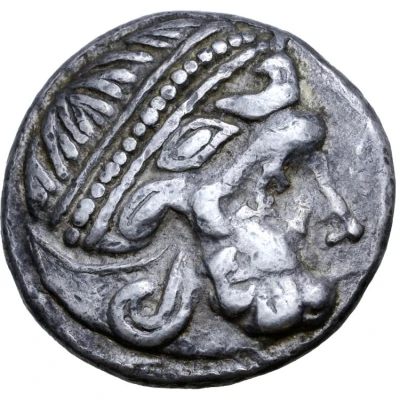


© Roma Numismatics Limited
Tetradrachm Janiform Type 300 BC - 201 BC
| Silver | 12.74 g | 23 mm |
| Issuer | Uncertain Eastern European Celts (Uncertain Central and Eastern European Celts) |
|---|---|
| Type | Standard circulation coin |
| Years | 300 BC - 201 BC |
| Value | Tetradrachm (4) |
| Currency | Drachm |
| Composition | Silver |
| Weight | 12.74 g |
| Diameter | 23 mm |
| Shape | Round (irregular) |
| Technique | Hammered |
| Orientation | Variable alignment ↺ |
| Demonetized | Yes |
| Updated | 2024-10-09 |
| Numista | N#190760 |
|---|---|
| Rarity index | 100% |
Reverse
Rider on horseback to right, wearing helmet with long crest; rosette before, branch growing out of torque in front of foreleg.
Comment
Examples of this type:• Example #1 (12.74g, 23mm, 6h; Extremely Fine) - In main image
◦ Ex-Hermann Lanz Collection; published in Kostial #546;
◦ Exhibited by the Staatlichen Münzsammlung München at the 1997 International Numismatic Congress in Berlin; at the Berliner Bank also in 1997; also exhibited at the Luitpoldblock Palmengarten, Munich in 2003 (exhibition #95[reverse]);
◦ Auctioned by Roma Numismatics Ltd, Auction XVIII, 29 September 2019, lot 140. Sold for 4,200 GBP.
◦ Auctioned by Numismatik Lanz München, Auction 42, 23 November 1987, lot 28.
Interesting fact
The Tetradrachm (Janiform Type) coin from Uncertain Eastern European Celts (Uncertain Central and Eastern European Celts) features a unique design element - a janiform, or double-faced, portrait of the Celts' ruler. This distinctive feature was used to symbolize the ruler's power and authority, as well as to convey the idea of duality and balance. The use of this motif in Celtic art and coinage was influential in the development of similar designs in later cultures, and it remains a notable aspect of ancient Celtic art and symbolism.



